Introduction
The research paper seeks to provide a descriptive analysis of the various demographic, social and economic indicators of the foreign-born Chinese in Massachusetts. The specific areas that will be analyzed include age distribution and marital status, education, employment, earnings and medical insurance coverage of the foreign-born Chinese. Further, a comparison will be made with foreign-born Chinese in the United States. The data for the analysis will be retrieved from reports of American Community Survey and United States Census Bureau web sites (United States Census Bureau 1).
Demographics
The foreign-born in Massachusetts account for 14.94% of the total population of the state. This shows that the native-born amount to the largest percentage of the population. The foreign-born Chinese are 6.90% of the foreign-born population in Massachusetts. The total number of Chinese accounts for only 1.68% of the total population of Massachusetts. When compared to the total population of the United States, the Chinese number to 0.04% of the total population of the United States. The proportion of the foreign-born is 14.83% of the entire population of the United States (United States Census Bureau 1). The foreign-born Chinese account for 0.17% of the total population of foreign-born in the United States.
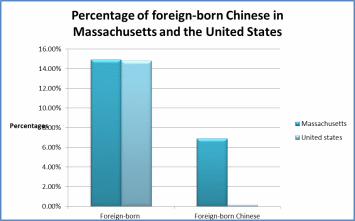
Therefore, it can be noted that the proportion of foreign-born Chinese is quite low if compared to the total population of foreign-born in Massachusetts and the United States in general. The foreign-born residents in Massachusetts can also be analyzed from a historical point of view (United States Census Bureau 1). This will be achieved by looking at the population of the foreign-born in the state over a certain period of time.
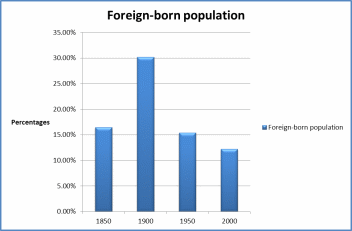
The population of the foreign-born residents started to sprout back in 1850. The percentage of foreign-born continued to grow in 1900 due to favorable immigration laws that allowed immigrants from various parts of the world to enter into the country. The percentage of foreign-born residents in Massachusetts has declined in the recent years due to tighter immigration laws (Immigration Policy Institute 1). For instance in 2008, the foreign-born residents accounted for 14.4% of the total population. Apart from the distribution of the foreign-born in Massachusetts, analysis can also be carried out on the distribution of the citizens and non-citizens foreign-born Chinese in Massachusetts. The statistics show that 66.92% of Chinese in Massachusetts are its citizens while 33.07% of them are non-citizens. On the other hand, 91.25% of the residents of Massachusetts are considered to be its citizens while the remaining 8.75% of the population are non-citizens (Lien 6).
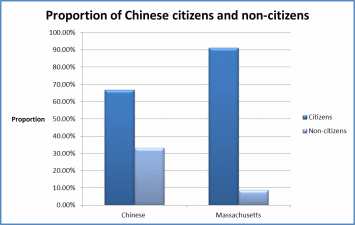
Age distribution and marital status
The population of foreign-born Chinese in Massachusetts comprise 45.7% male and 54.3% female. The distribution is slightly different from the proportion of the male (50.3%) and female (54.3%) foreign-born residents in the United States. It shows that the proportion of foreign-born female Chinese is higher than the proportion of total female in the entire foreign-born population (United States Census Bureau 1).
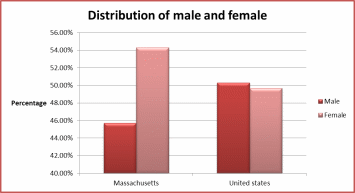
The distribution of male and female has an impact on other variables, such as the households and families. Further, based on the distribution of age, the foreign-based Chinese residents in Massachusetts are made up of older people. The age distribution shows that 1.5% of the population are children below five years, 5.7% lies between 5 to 17 years, 7.3% of the population is between 18 to 24 years, 16.2% comprises people between 25 to 34 years, 22.1% is between 35 to 44 years, 19.4% includes the population between 45 to 54 years, 12.9% is between 55 to 64 years, 8.3% is aged between 65 to 74 years, while 6.6% of the population has an age of 75 year and above. The distribution shows that 69.3% of the foreign-born Chinese residents are 35 years old and above. The remaining 30.7% of the residents are under 35 years.
The age distribution of the foreign-born Chinese in Massachusetts follows the same trend as the age distribution of the foreign-born residents in the United States. In the United States, 37.9% of the foreign-born residents are under 35 years while 62.1% of the population is above 35 years old (United States Census Bureau 1). The statistics indicate that the foreign-born residents in the Unites States include older people.

Further, the median age of the foreign-born Chinese in Massachusetts can be analyzed. The median age of the foreign-born Chinese is 43 while the median age of the foreign-born in Massachusetts is 42. Further, the median age of the native-born Chinese is slightly lower at 17 while the median age of the foreign-born in Massachusetts is 38. The median age can also be analyzed in terms of citizens and non-citizens. Chinese citizens have a median age of 26 while Chinese non-citizens have a median age of 39. On the other hand, the median age of Massachusetts’ citizens is 39 while the median age for Massachusetts’ non-citizens is 36. Therefore, on average it can be observed that the median age of the resident of Massachusetts is higher than the median age of Chinese residents (United States Census Bureau 1). When compared to the entire United States, the foreign-born residents have a higher median age.
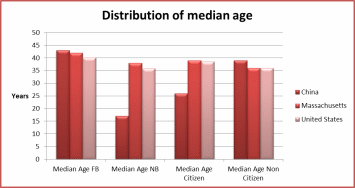
Since the population of the foreign-born Chinese in Massachusetts comprise older people. It indicates that the families do not have to spend a lot of money on education because they are economically productive. Besides, the distribution of age indicates that the population of the foreign-born Chinese contribute immensely to the economic growth and development of Massachusetts and the entire United States.
Further, the population of the foreign-born Chinese in Massachusetts can be analyzed in terms of the marital status. Statistics show that the proportion of the married foreign-born Chinese is 66.44%. This number is higher than the percentage of the residents in Massachusetts (46.85%). Besides, the statistics reveal that a large number of foreign-born Chinese (66.44%) are married to the native-born Chinese (30.7%). Further, a large percentage of Chinese non-citizen residents (65.29%) are married as compared to the Chinese citizens (51.52%). The distribution of the citizens and non-citizens can be a result of the large proportion of the foreign-born Chinese non-citizens in Massachusetts. Further, it can be noted that the proportion of married foreign-born Chinese (66.44%) is lower than the proportion of the foreign-born in the United States (48.5%).
The high proportion of the married foreign-born Chinese can be attributed to the fact that large proportion of the population is older than the proportion of the foreign-born residents in Massachusetts and the United States. The statistics further show that 71.5% of the foreign-born Chinese male in Massachusetts aged above 15 years are married while only 66.5% of the foreign-born Chinese female of the same age are married. This distribution will have an impact on the families (Kwok-bun 269).
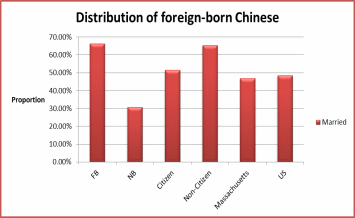
Thus, based on the graph above, it can be observed that the foreign-born Chinese have the highest proportion of married residents.
Education
The statistics show that 50.59% of the foreign-born Chinese residents have attained bachelors degree and above. The percentage is quite high in relation to the residents of Massachusetts (29.13%). Further, 25.11% of the foreign-born Chinese residents have not attained a high school education, 16.07% of the population have finished a high school while 8.22% of the population have gained some college education. However, the educational attainment is evenly distributed across the various levels of education in case of foreign-born residents in Massachusetts (United States Census Bureau 1).
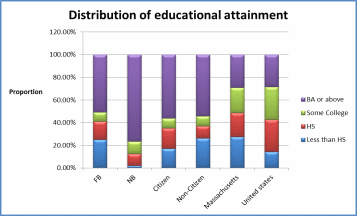
Thus, it can be observed that foreign-born Chinese have the highest proportion of residents who have attained bachelor’s degree when compared to Massachusetts’ and United States’ population. This can be attributed to the immigration laws in place. Besides, this contributes positively to the economic growth of the region. Education can also be analyzed based on the school enrollment. The enrollment for nursery school stands at 3.8%, kindergarten at 1.6%, elementary school at 18.9%, high school at 13.7% and college at 61.8%. The distribution can support the high percentage of foreign-born Chinese residents who have college education and above (United States Census Bureau 1).
Labor force participation
The statistics show that 61.59% of the total foreign-born Chinese residents participate in the labor force. Further, 47.05% of the native-born Chinese residents take part in the labor force. Also, 67.64% of the Chinese citizens are involved in the labor force while 43.45% of the non-citizens participate in the labor force. Even though the proportion of the foreign-born non-citizens Chinese residents is higher than the same of the foreign-born citizens Chinese residents, it can be noted that the proportion of citizens Chinese residents who participate in the labor force is higher than that of non-citizens Chinese residents (United States Census Bureau 1).
This may indicate that Chinese citizens have a higher chance of getting jobs in Massachusetts than non-citizen Chinese residents. Further, it can be observed that the proportion of the foreign-born Chinese residents who participate in labor force (61.59%) is lower than the residents in Massachusetts (67.66%) and foreign-born in the United States (64.50%). The statistics show that the population of the foreign-born from different origins has a higher chance of getting jobs than the foreign-born Chinese residents have.
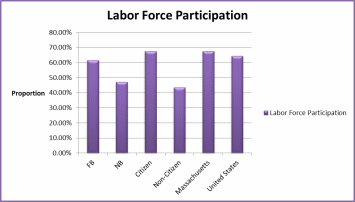
Further, a relatively small proportion of the foreign-born Chinese residents are unemployed (8.05%). However, the number is higher than that of the native-born Chinese residents (5.60%). Further, the proportion of the unemployed residents of Massachusetts is higher (9.45%) than the proportion of the unemployed foreign-born Chinese residents (8.05%). This may indicate that relatively high proportion of the foreign-based Chinese is employed.
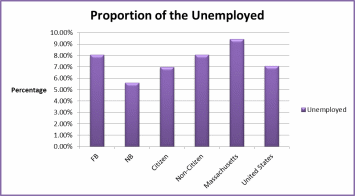
Earnings
The average income of the foreign-born Chinese households in the past twelve months is $763,313. The median household income of the foreign-born Chinese’s household is $61,943. Further, the median family income of the Chinese residents in the past twelve months has been $73,257. The statistics also reveal that the per capita of the foreign-born Chinese residents was $35,279. The distribution of earnings also shows that the median earnings for male full-time, year round workers ($70,130) were higher than those for females ($54,350).
Housing and medical insurance
Statistics show that the percentage of the Chinese residents with owner-occupied housing units was 60.6% while that of renter-occupied housing units was 39.4%. Thus, large percentage of the population has owner-occupied housing units. The proportion is slightly higher than the same of foreign-born residents in the United States where 54.4% of the population has owner-occupied housing units while 45.6% uses renter-occupied housing units. Further, in the case of the Chinese residents, the average household size of owner-occupied unit was 3.22 while the average household size of the renter-occupied housing unit was 2.46. The median gross rent paid by the Chinese residents ($897) is slightly higher than the median rent for foreign-born residents in the United States ($883) (United States Census Bureau 1).
The data further show that only 4.3% of the foreign-born Chinese residents doess not have medical insurance. The rest of the foreign-born residents have cover. The low percentage can be attributed to the rules in Massachusetts and the entire United States. The number is slightly higher than that for native-born Chinese (1.32%), Chinese citizens (1.53%) and residents of Massachusetts (4.26%). However, the amount is lower than that of the non-citizen Chinese residents (4.26%) and foreign-born residents in the United States (15.18%).
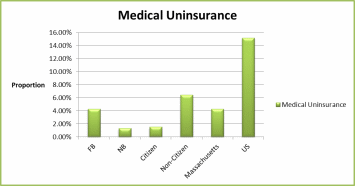
Works Cited
Immigration Policy Institute 2013, Chinese Immigrants in the United States. Web.
Kwok-bun, Chan. International Handbook of Chinese Families, Germany: Springer, 2012. Print.
Lien, Pei-te. “Behind the Numbers: Talking Politics with Foreign-born Chinese Americans.” International Migration 35.1 (2004): 87-112. Print.
United States Census Bureau 2013, American Community Survey. Web.